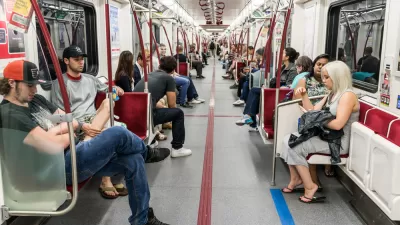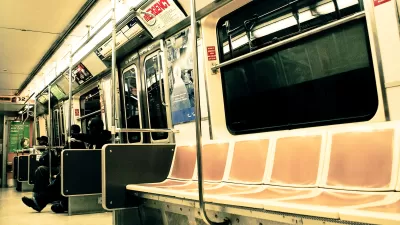The first "open gangway" subway cars are due to arrive in New York in 2020. These cars enable passengers to freely walk between cars without having to struggle to open doors to access an adjacent car.
The subway cars, common throughout the world including Canada, have been absent in the United States, explained Yonah Freemark in an extensive article last year (posted here). But that's going to change in New York, if not other U.S. cities fortunate enough to have heavy rail or metro systems.
In late January, the Metropolitan Transportation Authority (MTA) "released an image of the model, known as an open gangway plan, delighting train aficionados who had wondered when the idea would arrive in New York City," writes Emma G. Fitzsimmons of The New York Times.
[T]heir inclusion in a presentation [PDF—see images on page 63/112] to the authority’s board members brought to life an idea that has been debated for years.
Benefits of open gangways, as mentioned in the prior post, include:
- Increasing passenger capacity
- Increasing safety—facilitating movement to more populated cars during off-peak times
- Reducing crowding by allowing better distribution of passengers
Faster trains?
An additional benefit is that the cars could reduce "so-called dwell times at stations," writes Fitzsimmons. "If passengers are standing in a crowded car, they can walk to the next car and exit there, according to MTA spokesman Kevin Ortiz."
An interesting benefit enabled by the new cars in Toronto, in service since 2011, allowed the subway to turn into "Toronto’s longest civic living room," writes living columnist Shawn Micallef for The Star. "The new subways really are long rooms, not merely a series of train cars that get us from one place to another."
The open subway concept, where the voice announcements echo and reverb down the length of the train, also gives a better sense of the topography of the underground parts of the subway system. Every curve and bump is noticeable now. Try standing near one end and staring down the length for a few stops: you begin to feel the tunnels and city.
On the down side, only 10 have been ordered at a "cost [of] about $52.4 million," and won't arrive until 2020, adds Fitzsimmons. "[They] are included as part of the authority’s five-year capital plan, which is still awaiting approval from a state board."
“These are subway cars that will be running in our system for the next 30 or 40 years, conceivably,” Ortiz said. “We want to take our time and do our due diligence with the design of these cars.”
Currently, MTA's rules prohibit subway passengers to move between cars unless there is an emergency, notes Fitzsimmons.
Other New York subway car news posted here last year was of the inverse nature—the oldest cars will be phased out.
Hat tip to Peter Flieg.
FULL STORY: Open Subway Cars May Come to New York City as Early as 2020

Planetizen Federal Action Tracker
A weekly monitor of how Trump’s orders and actions are impacting planners and planning in America.

Congressman Proposes Bill to Rename DC Metro “Trump Train”
The Make Autorail Great Again Act would withhold federal funding to the system until the Washington Metropolitan Area Transit Authority (WMATA), rebrands as the Washington Metropolitan Authority for Greater Access (WMAGA).

The Simple Legislative Tool Transforming Vacant Downtowns
In California, Michigan and Georgia, an easy win is bringing dollars — and delight — back to city centers.

The States Losing Rural Delivery Rooms at an Alarming Pace
In some states, as few as 9% of rural hospitals still deliver babies. As a result, rising pre-term births, no adequate pre-term care and "harrowing" close calls are a growing reality.

The Small South Asian Republic Going all in on EVs
Thanks to one simple policy change less than five years ago, 65% of new cars in this Himalayan country are now electric.

DC Backpedals on Bike Lane Protection, Swaps Barriers for Paint
Citing aesthetic concerns, the city is removing the concrete barriers and flexposts that once separated Arizona Avenue cyclists from motor vehicles.
Urban Design for Planners 1: Software Tools
This six-course series explores essential urban design concepts using open source software and equips planners with the tools they need to participate fully in the urban design process.
Planning for Universal Design
Learn the tools for implementing Universal Design in planning regulations.
Smith Gee Studio
City of Charlotte
City of Camden Redevelopment Agency
City of Astoria
Transportation Research & Education Center (TREC) at Portland State University
US High Speed Rail Association
City of Camden Redevelopment Agency
Municipality of Princeton (NJ)





























